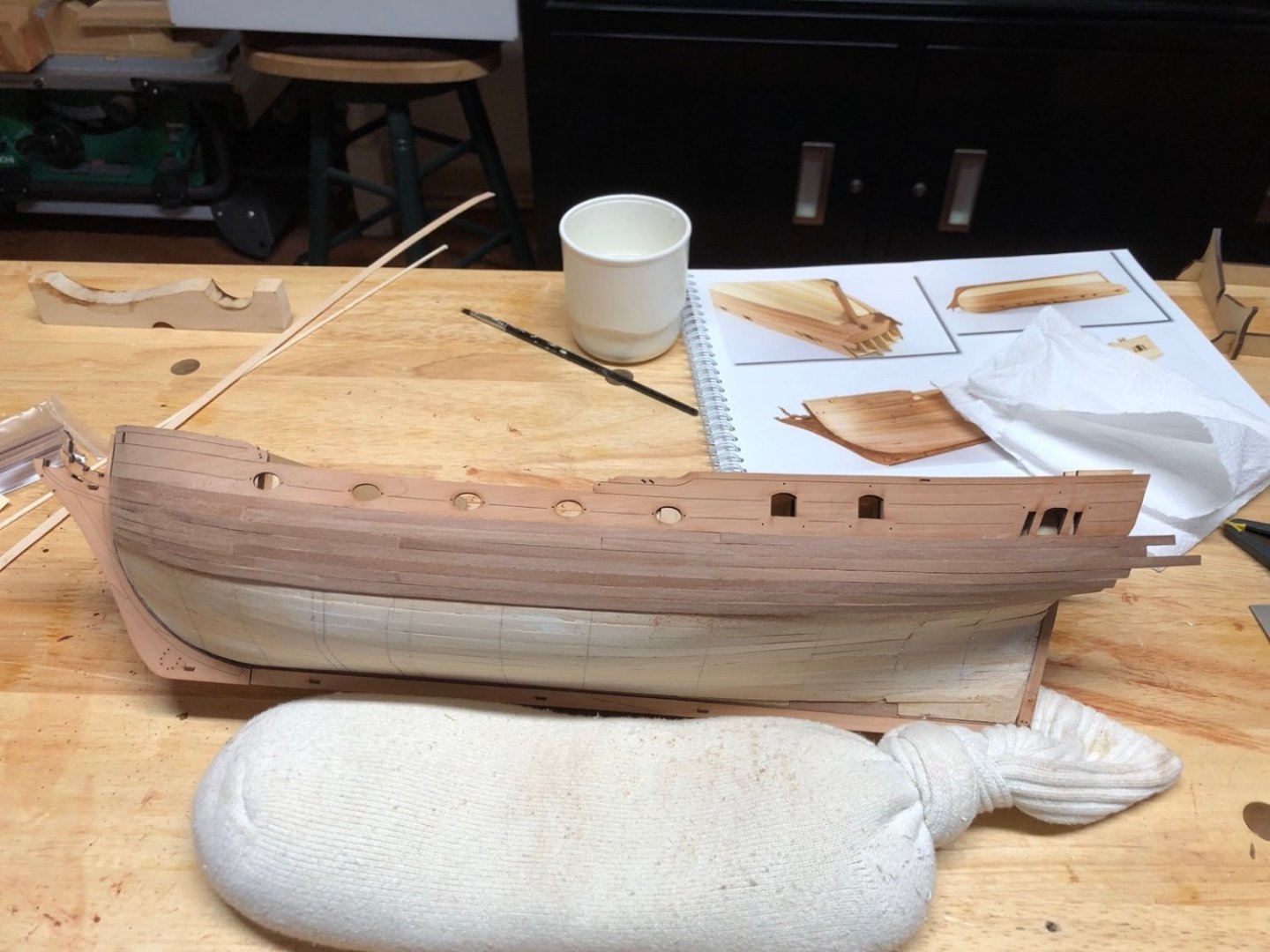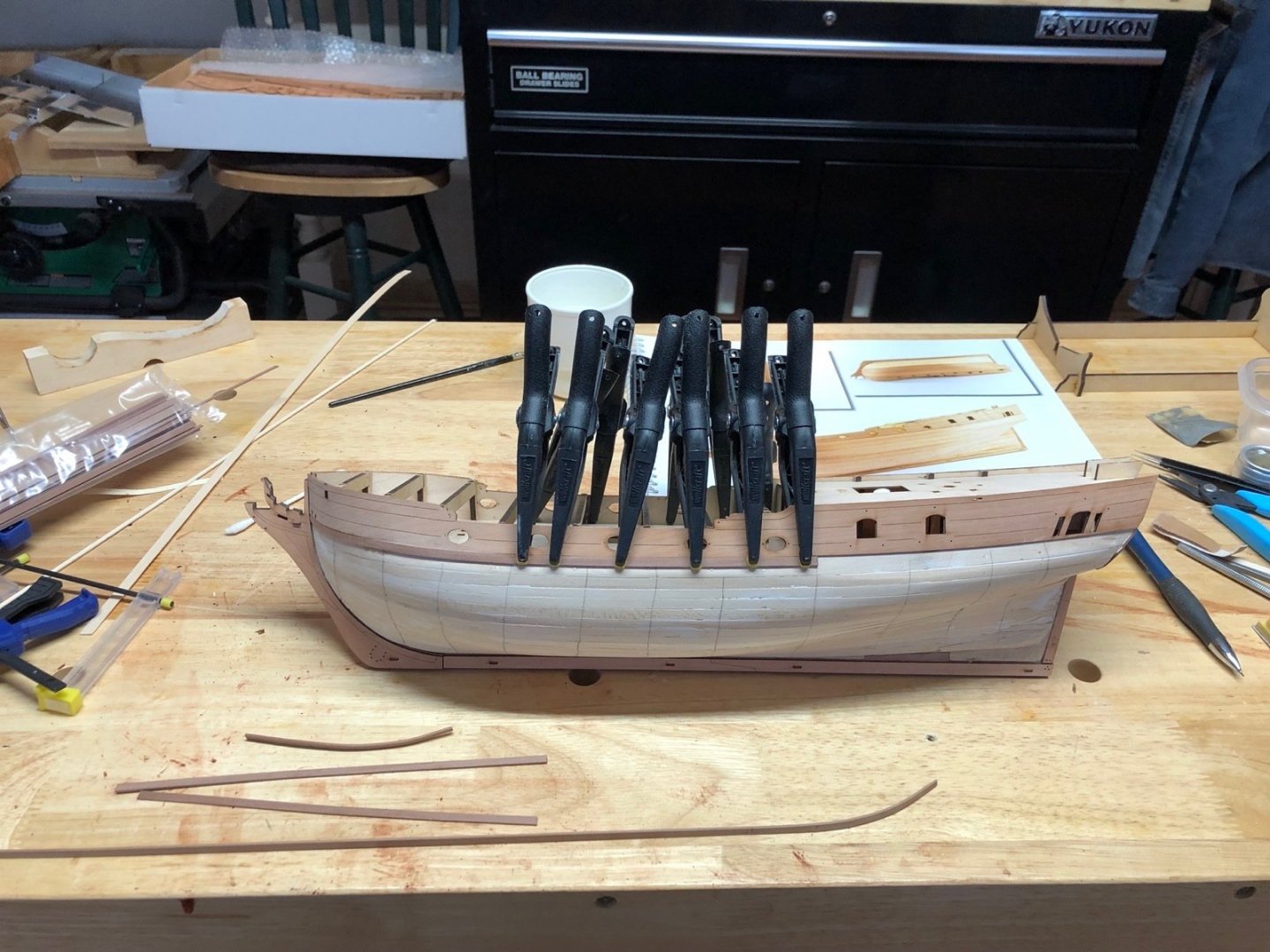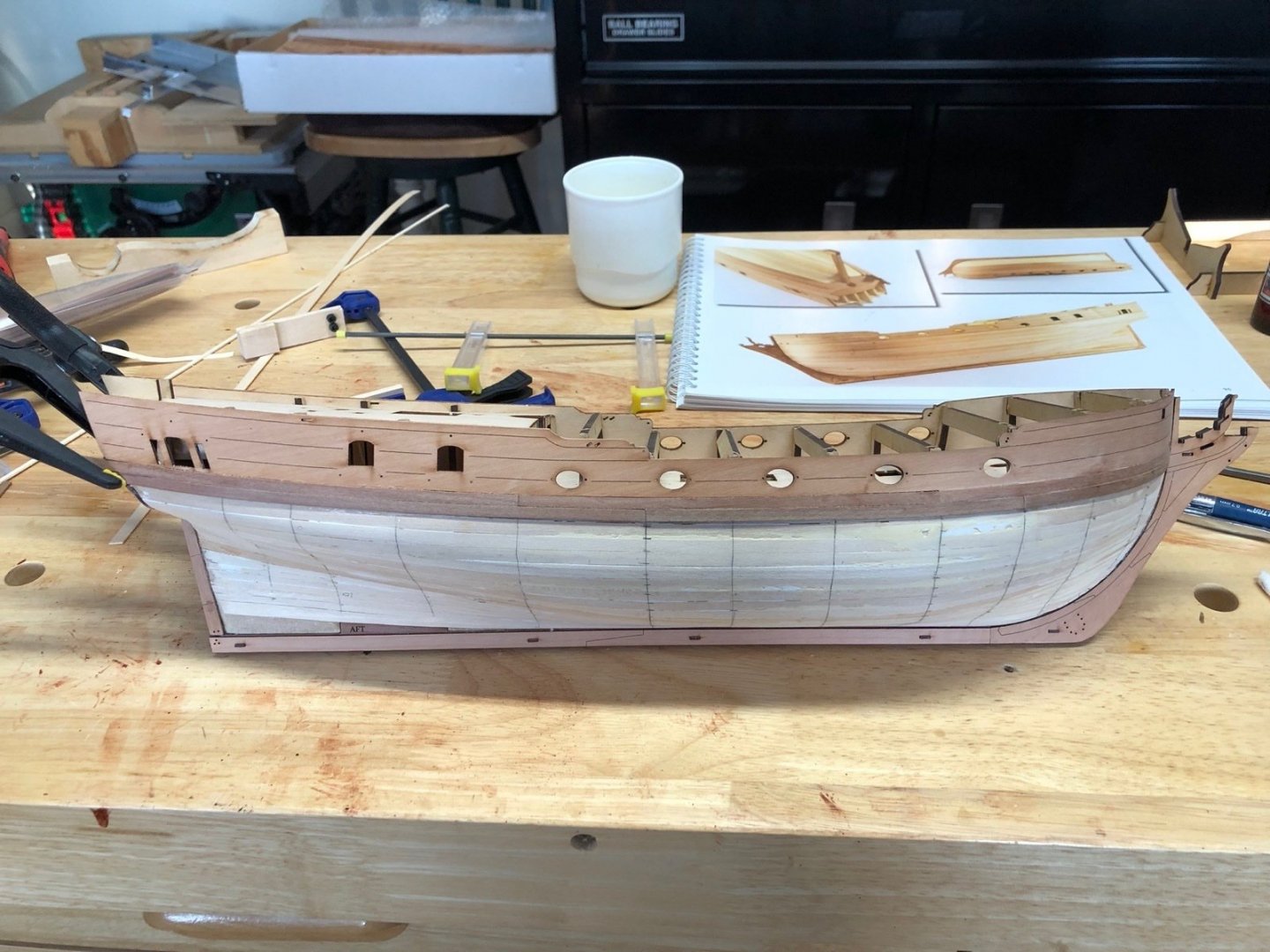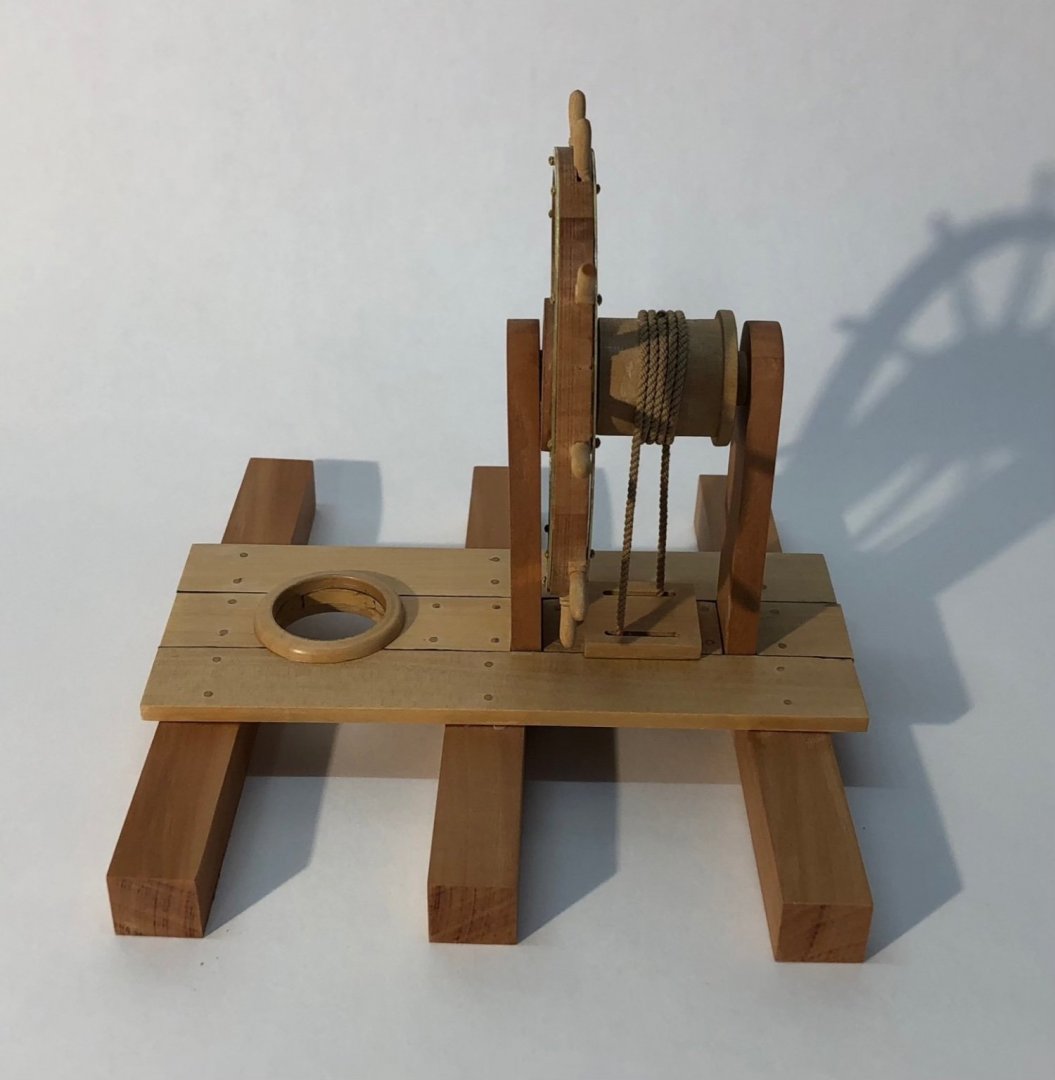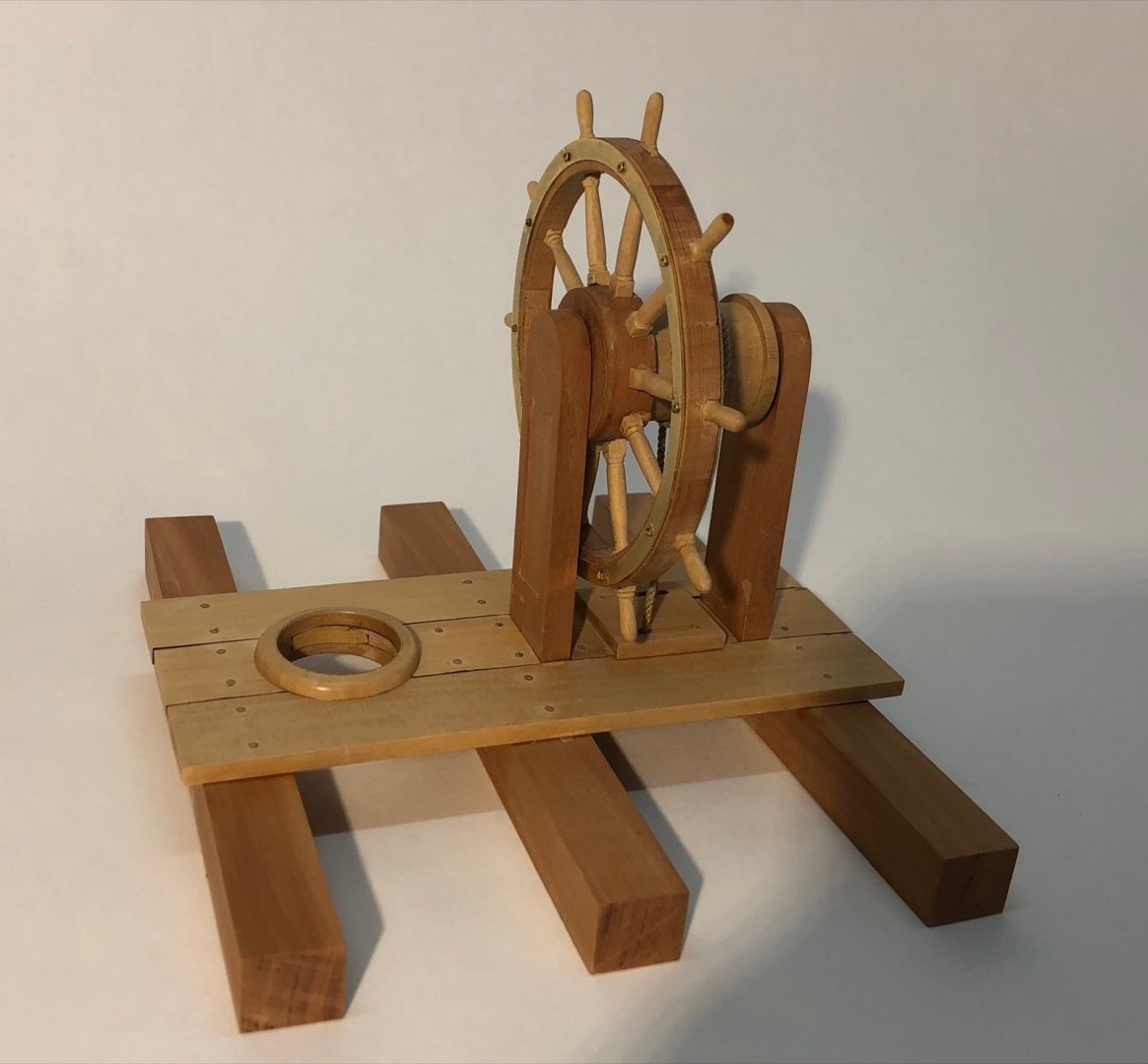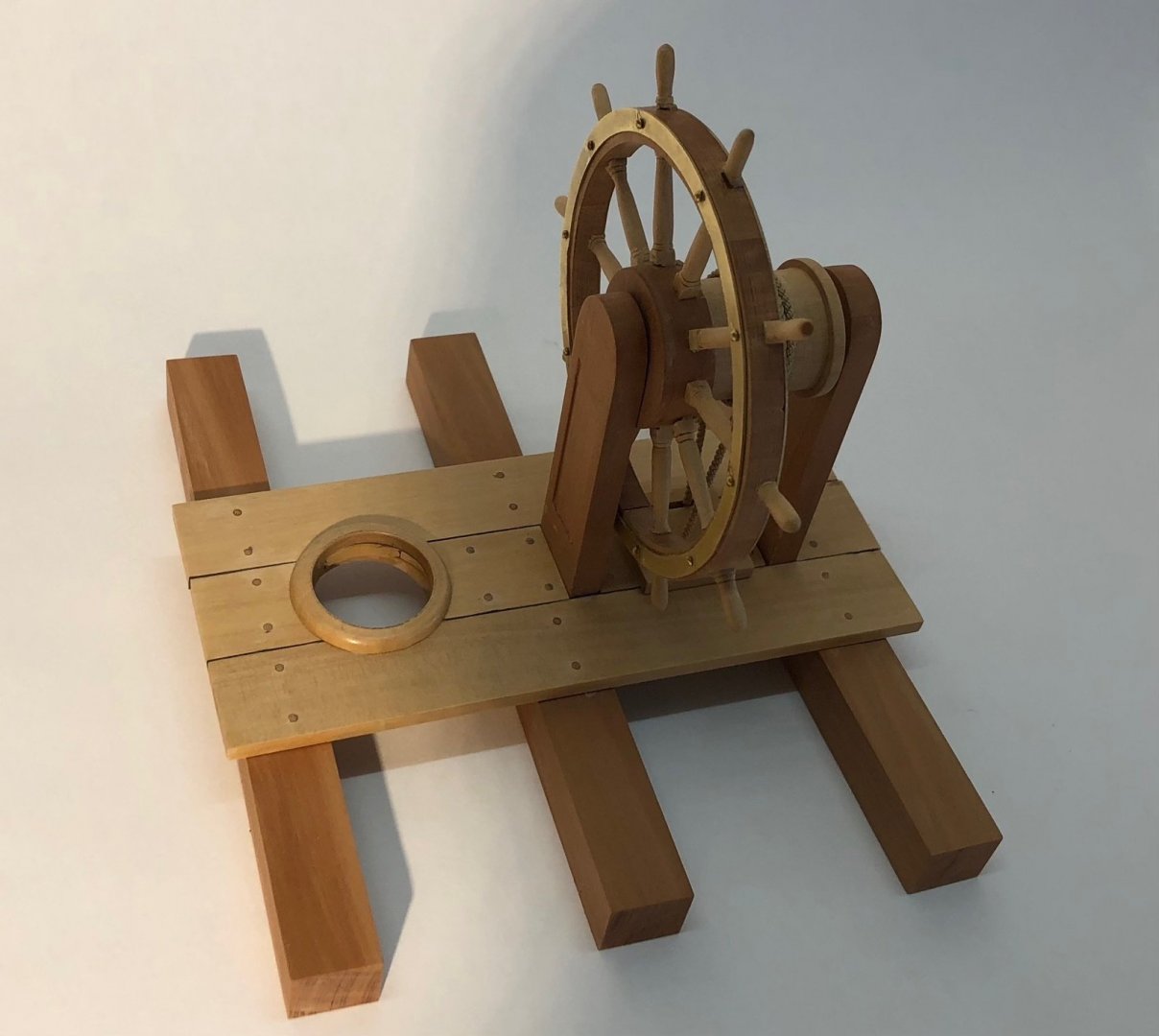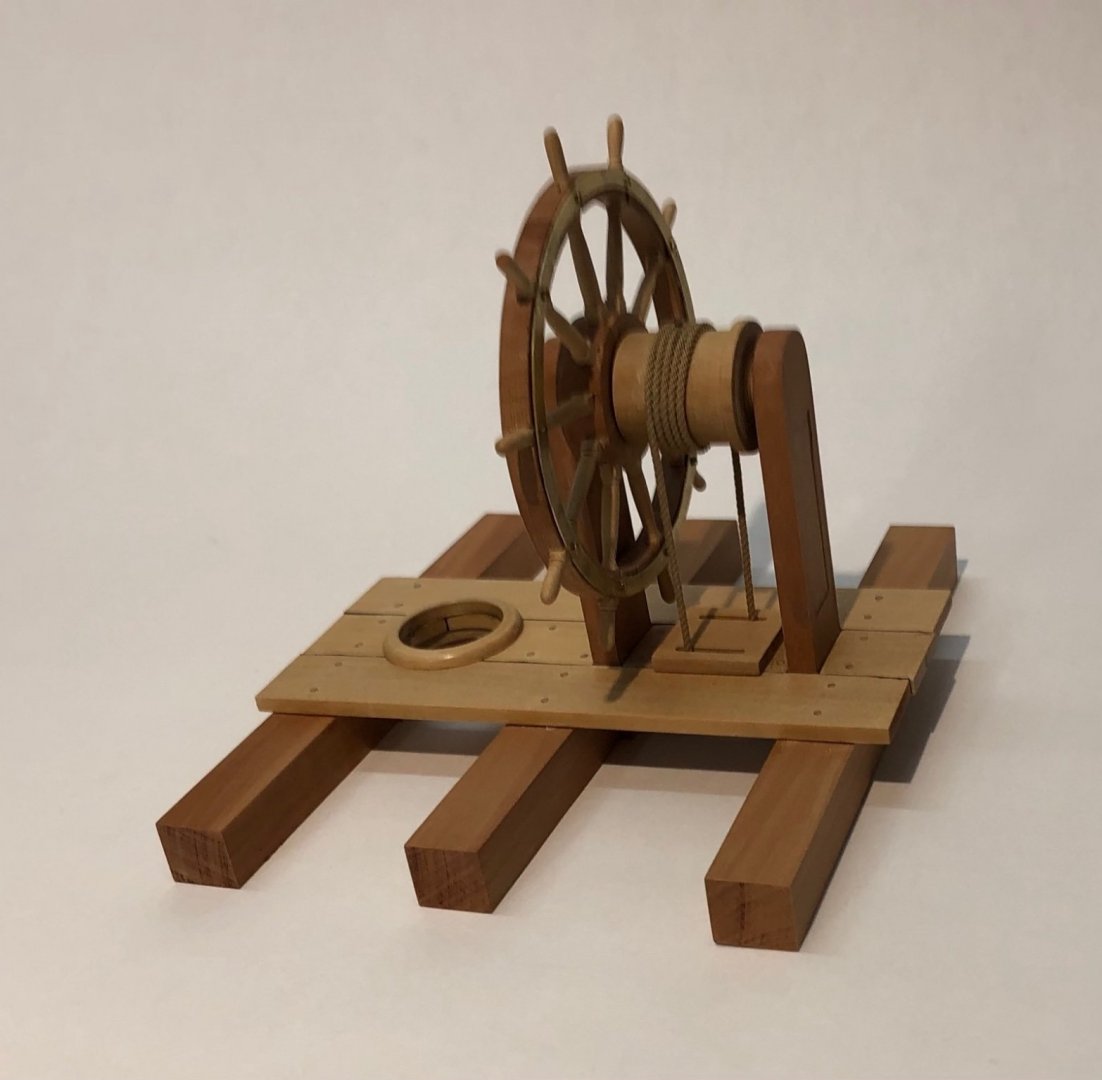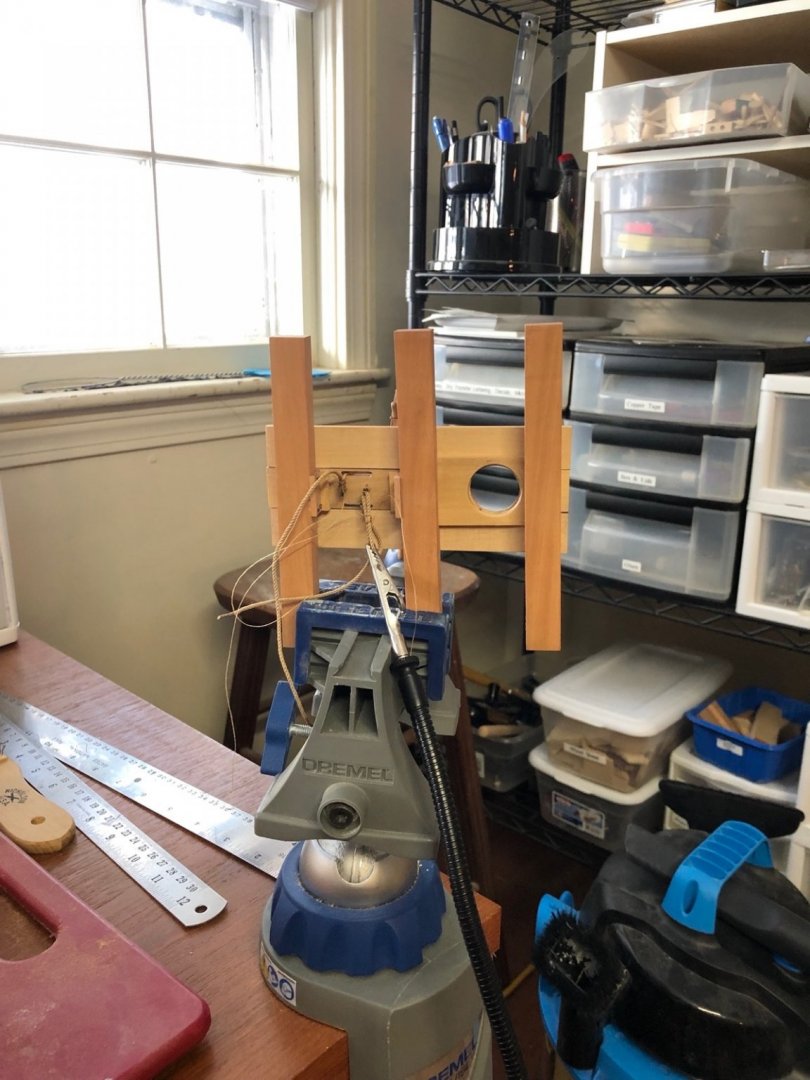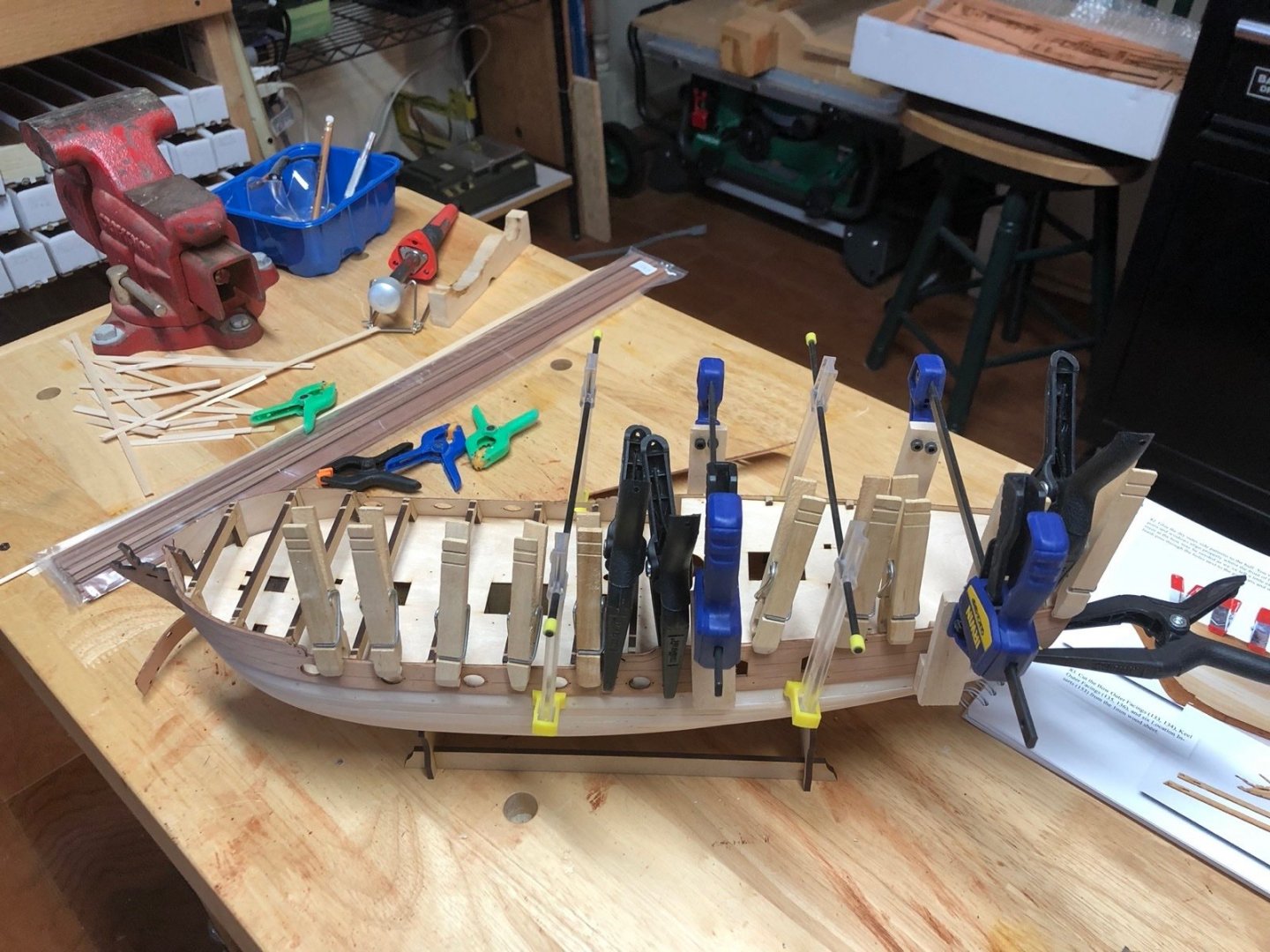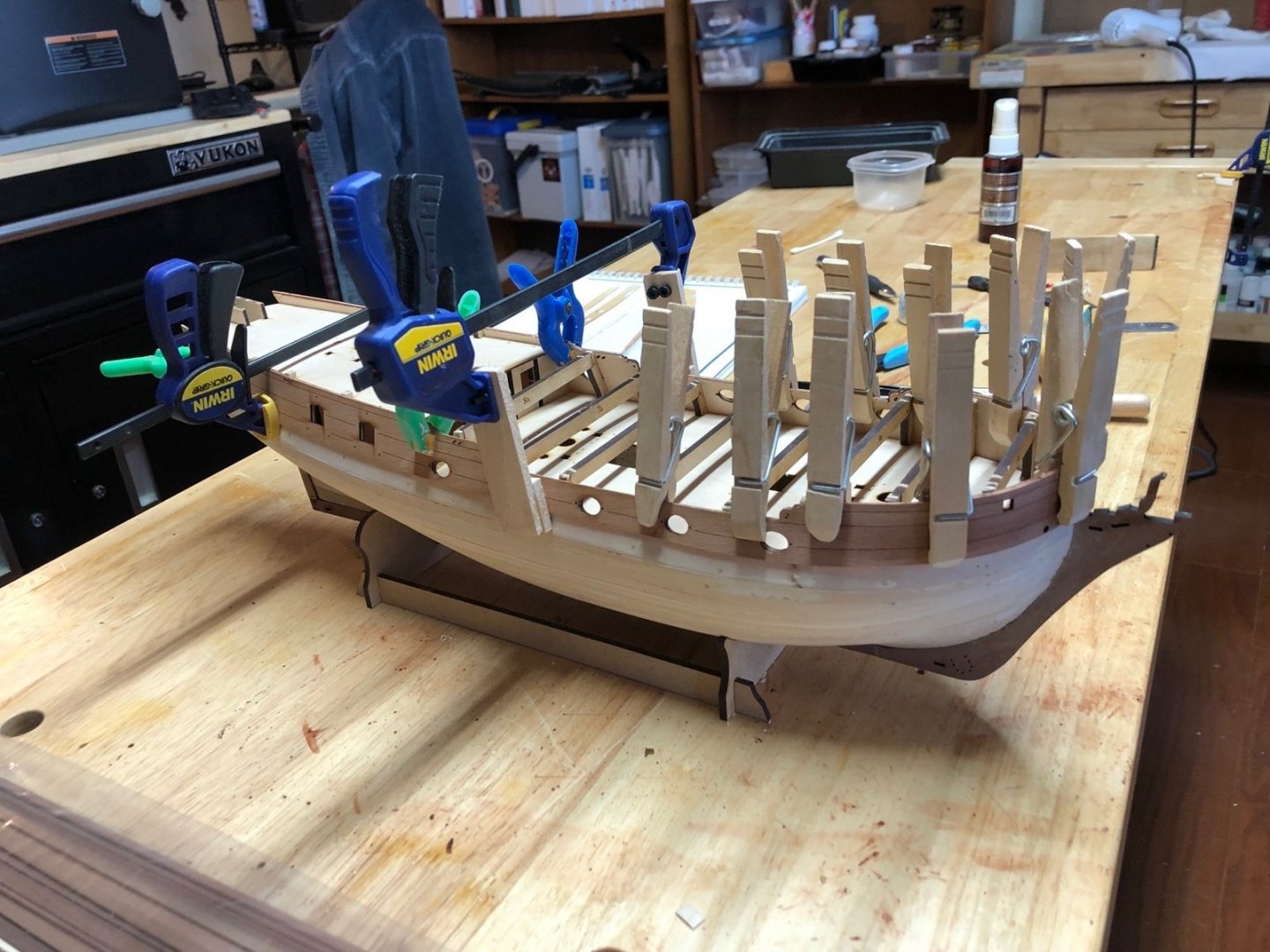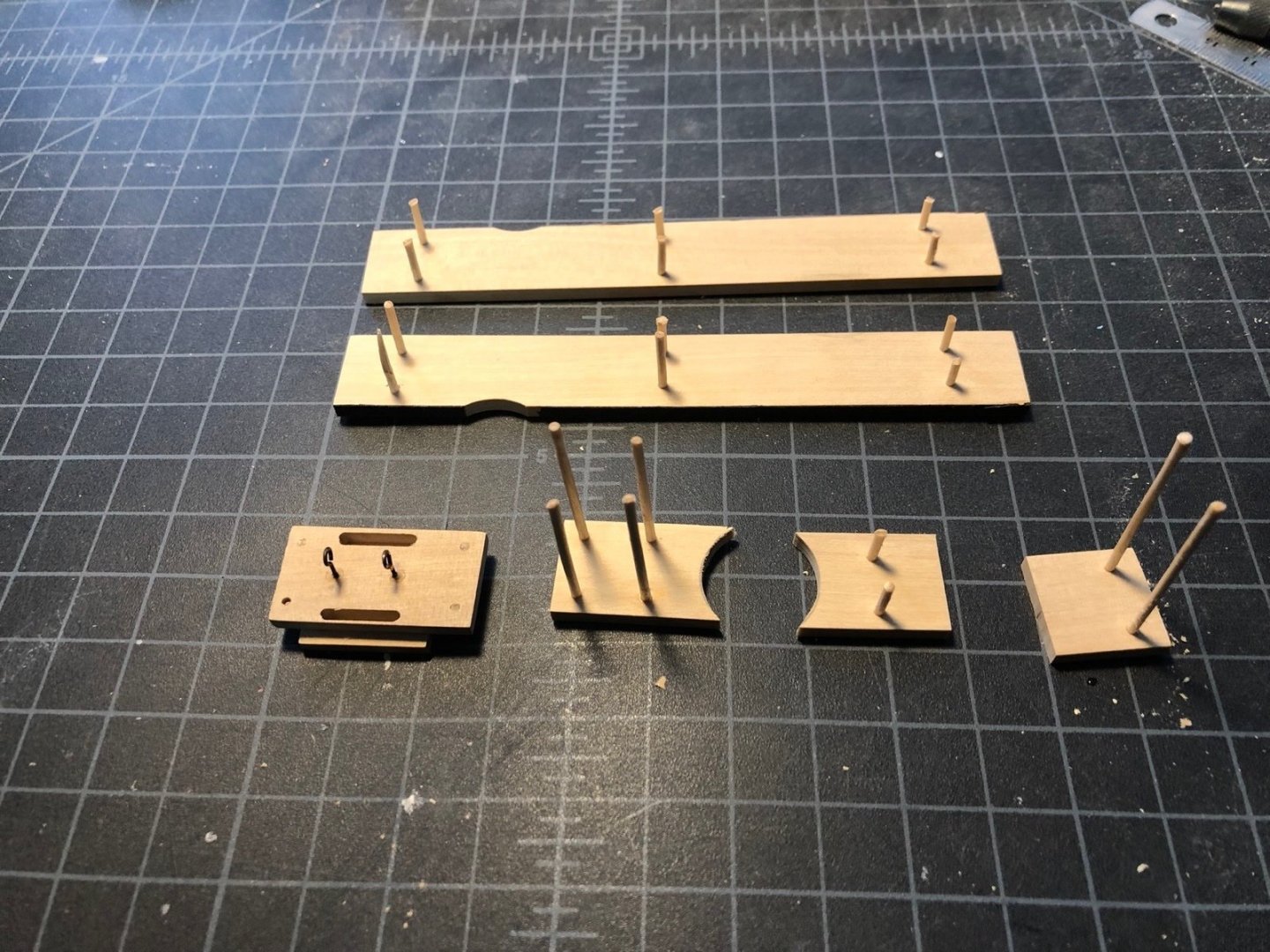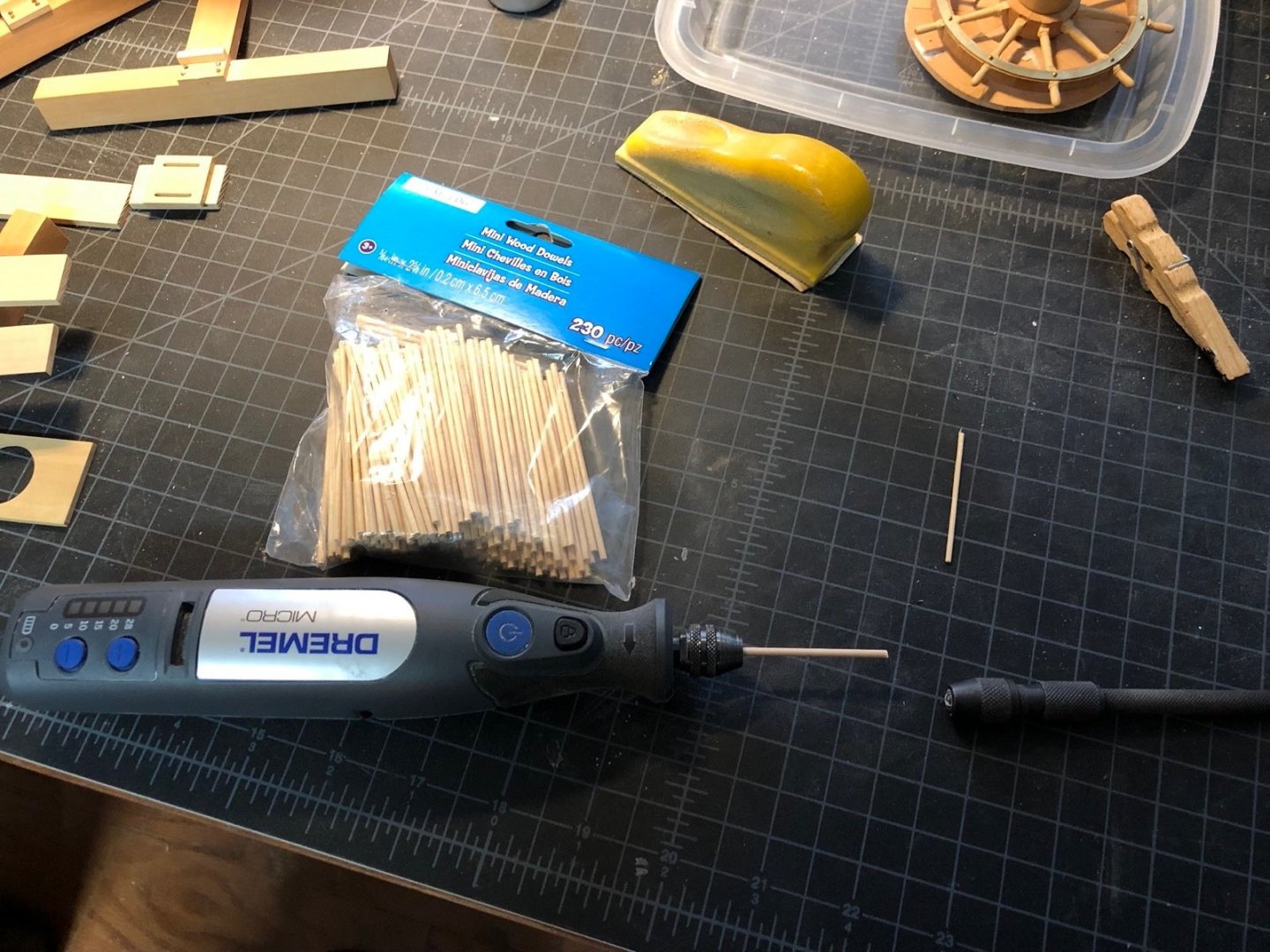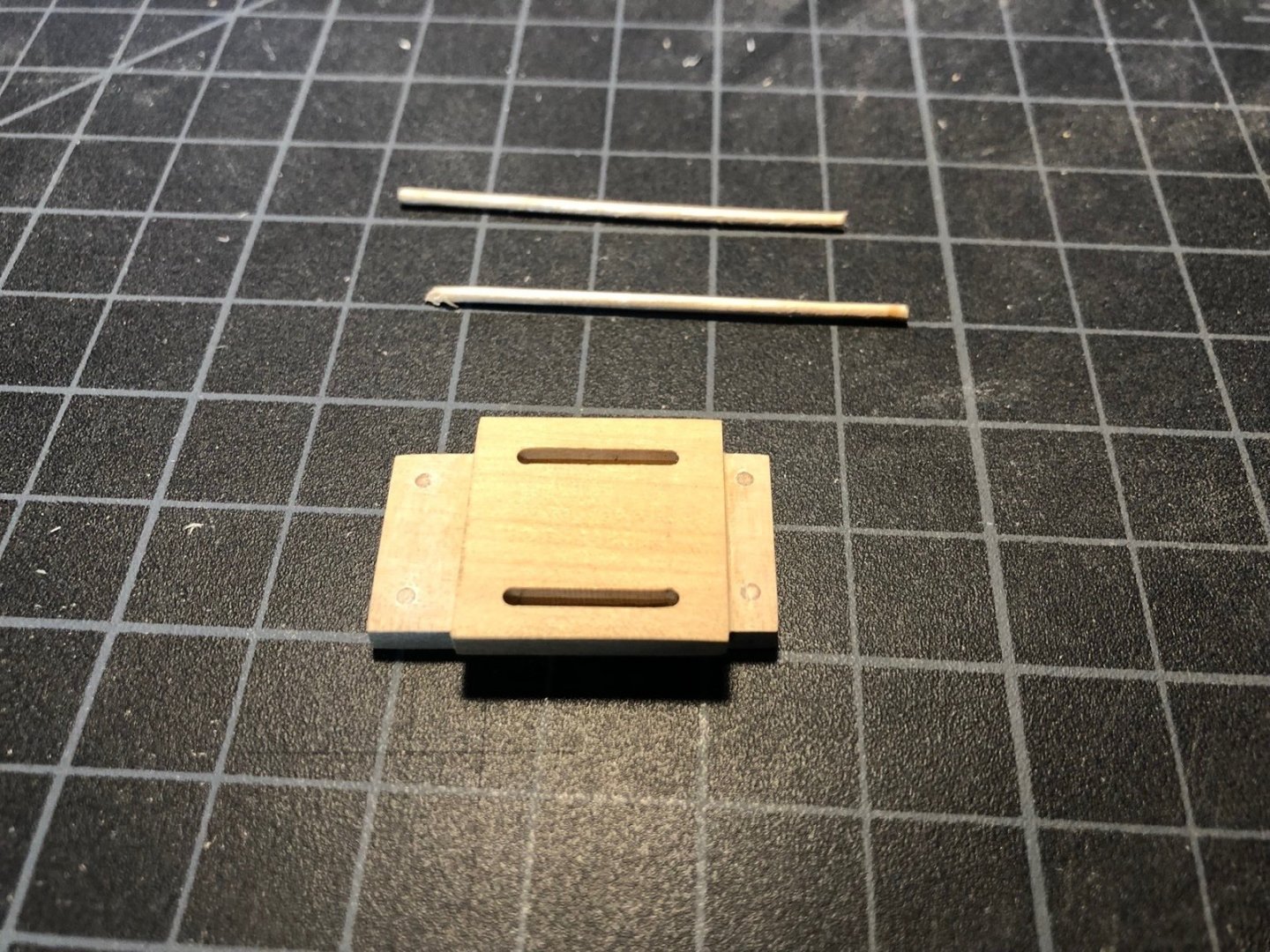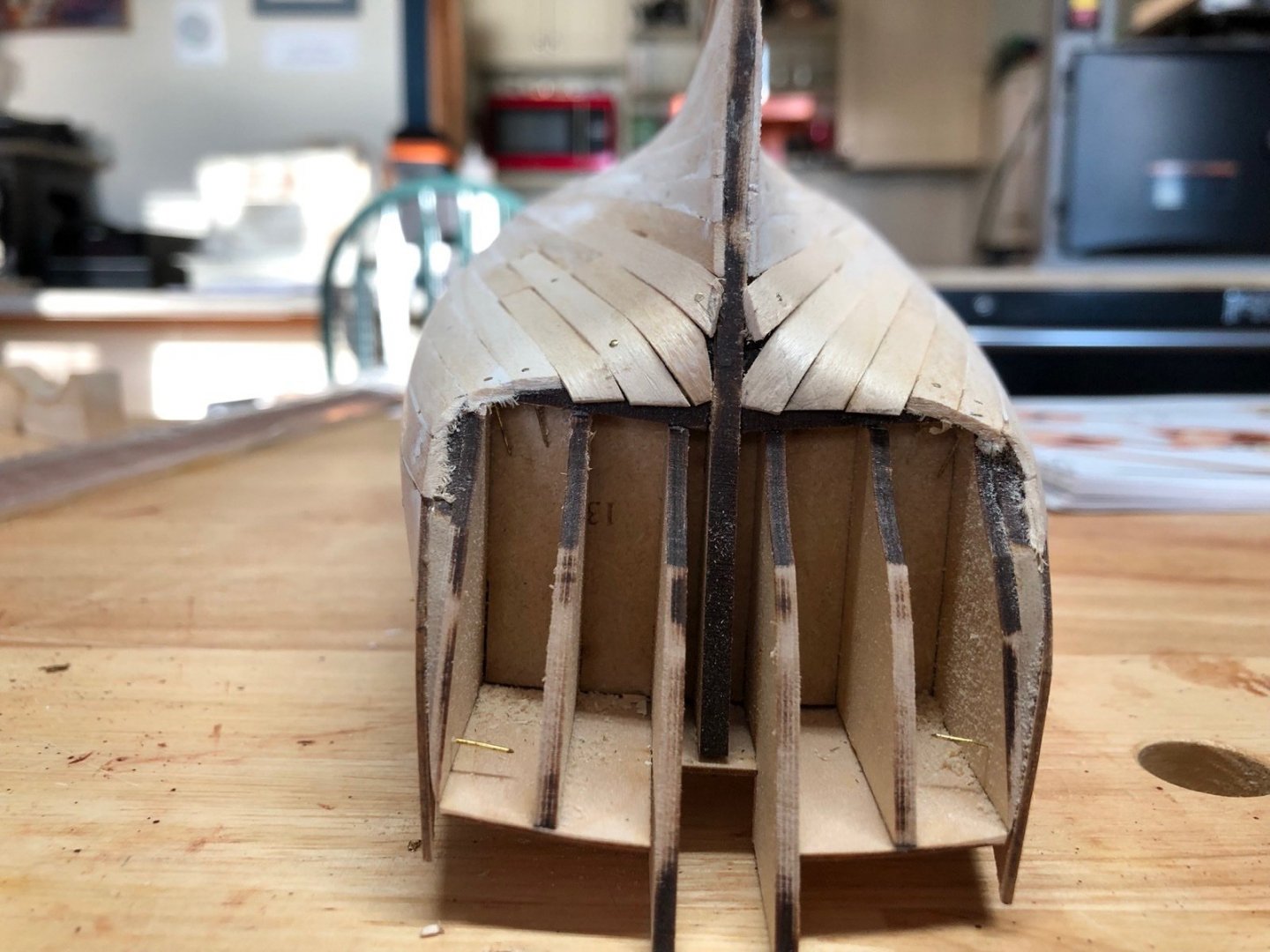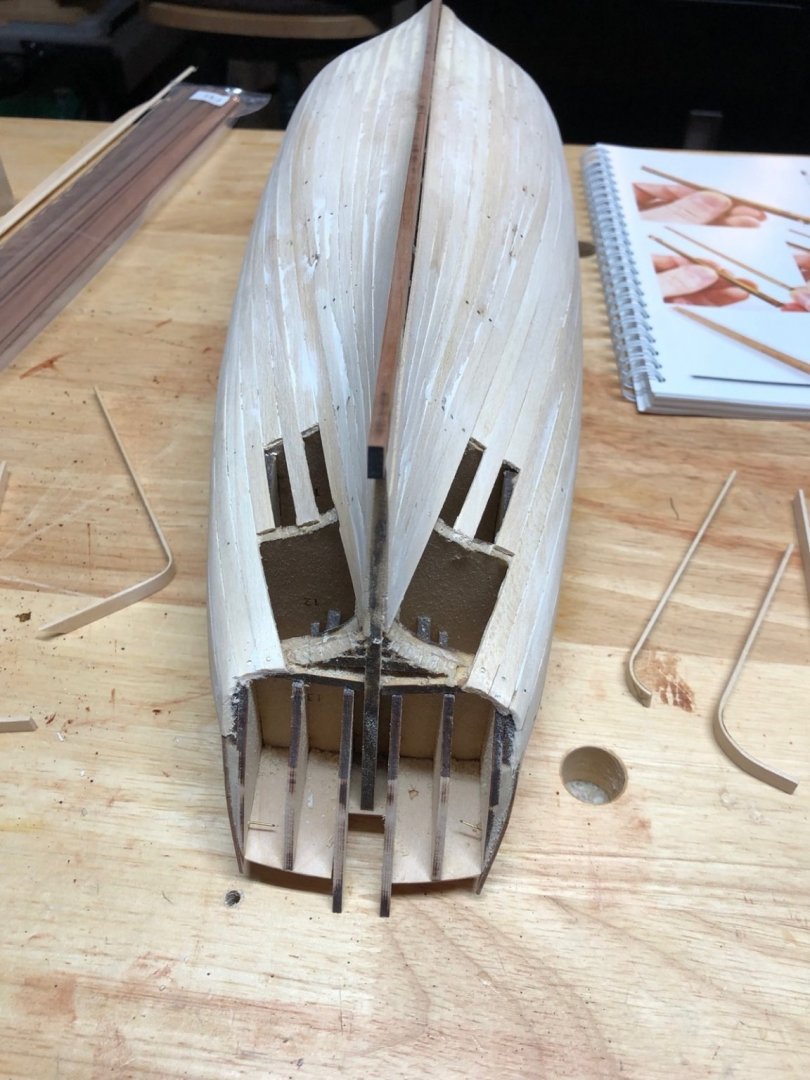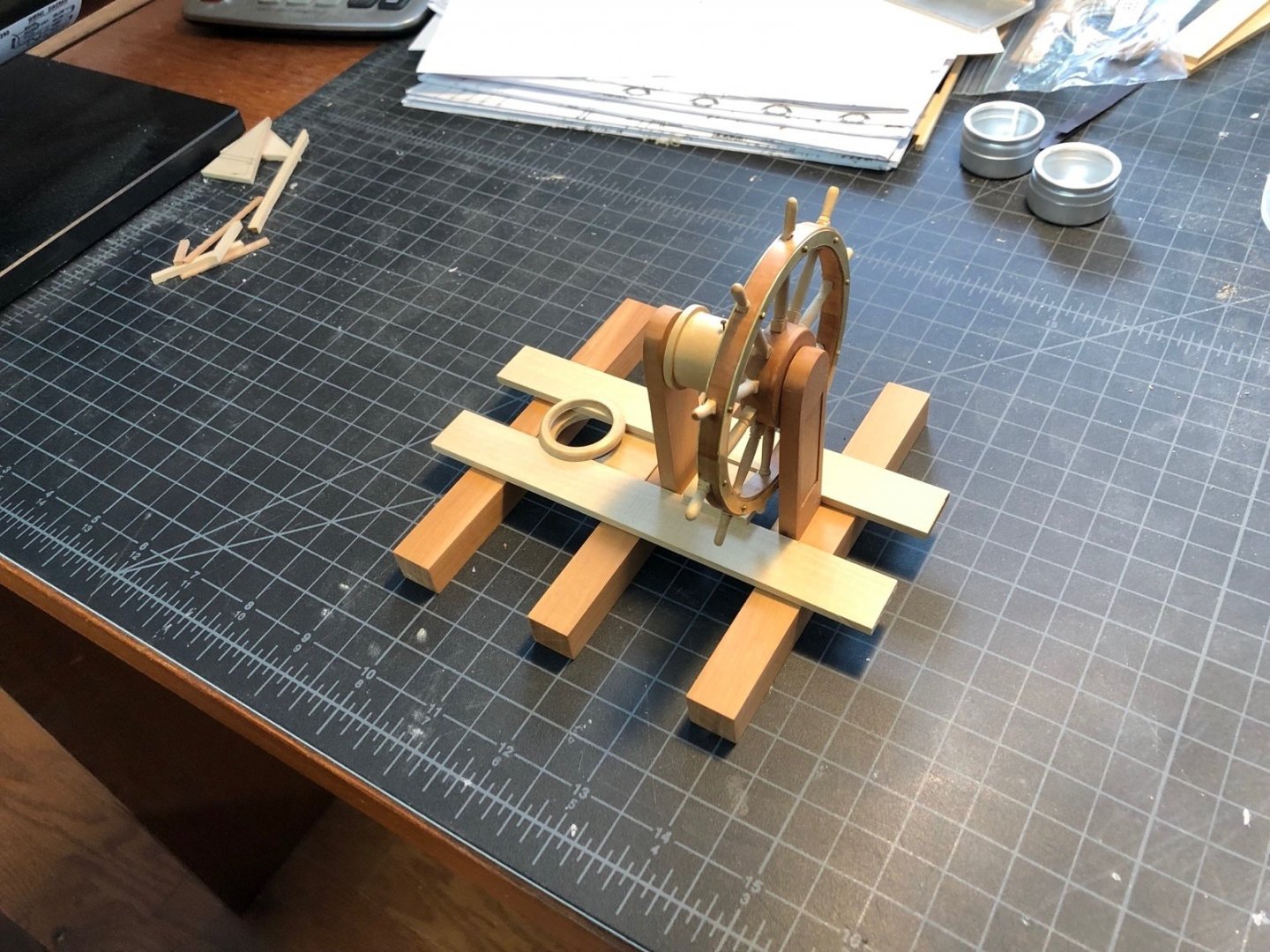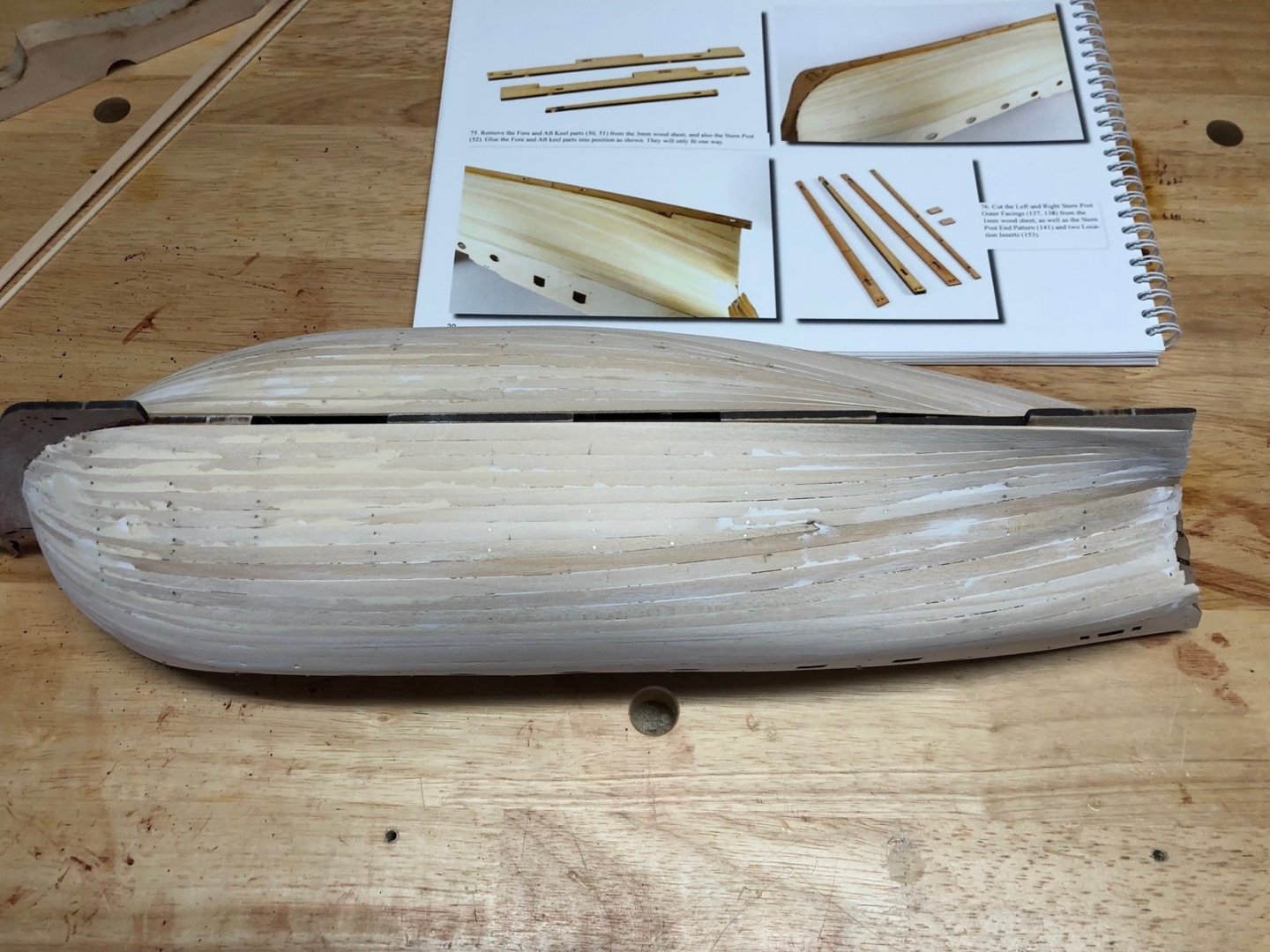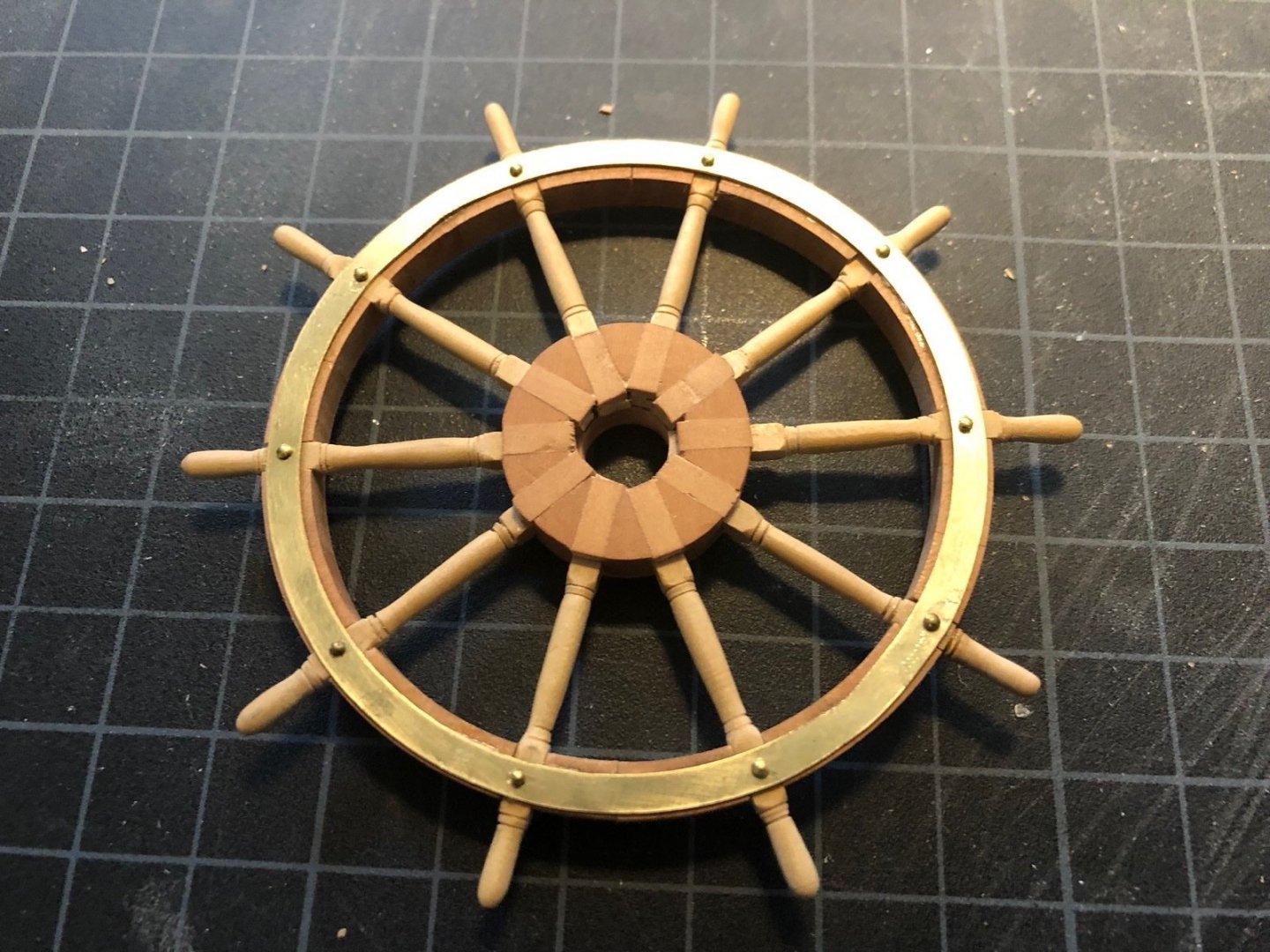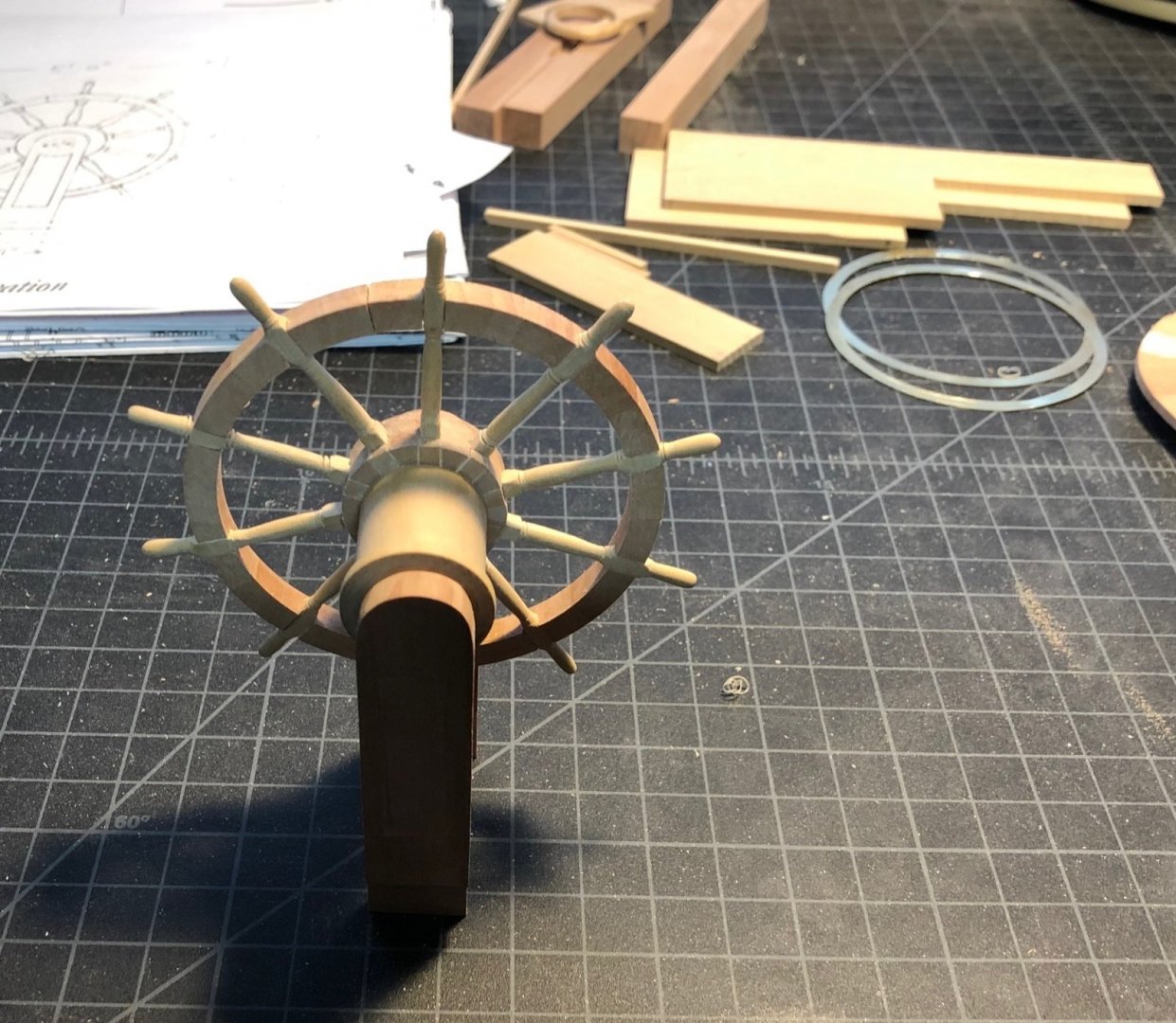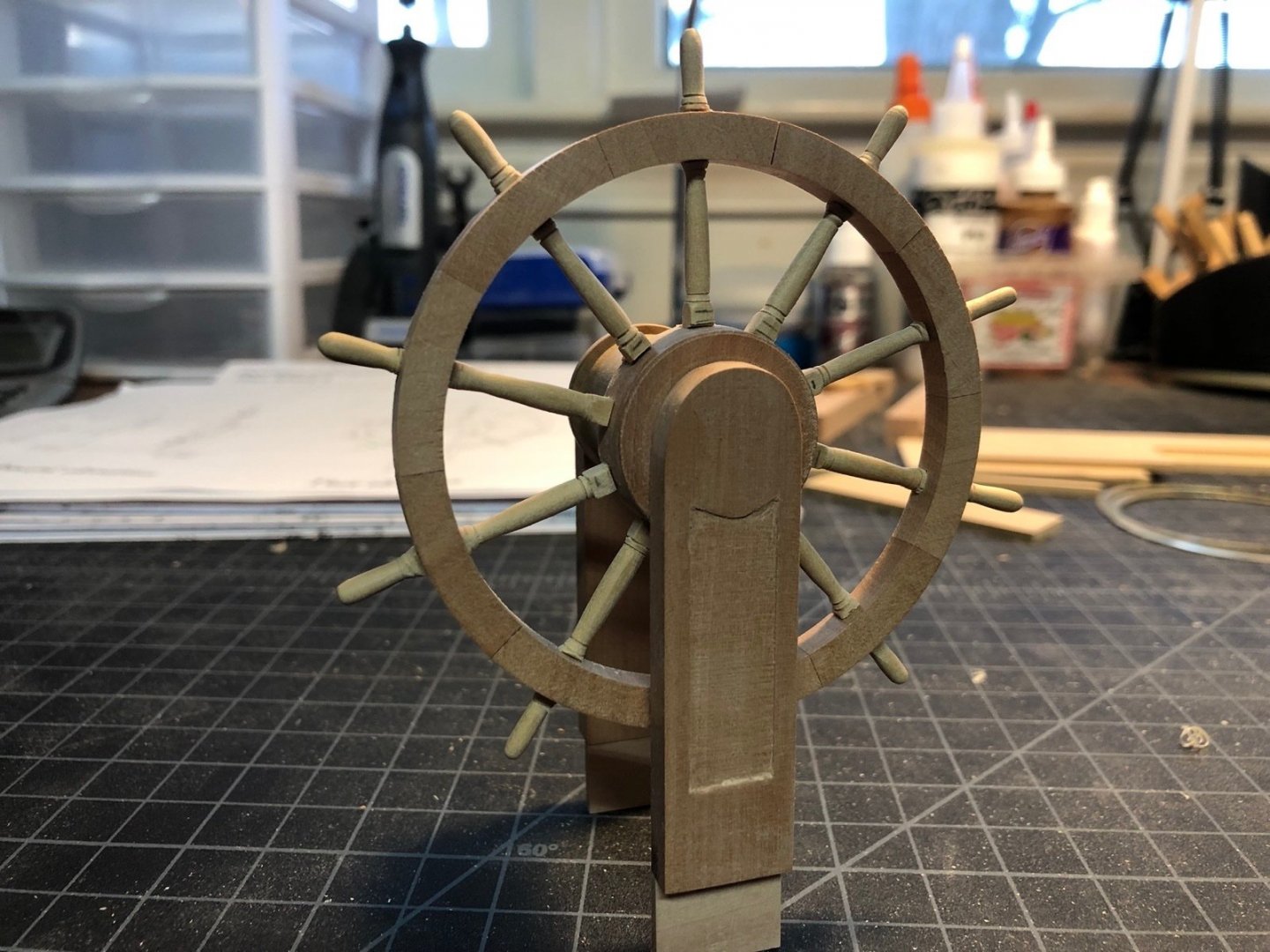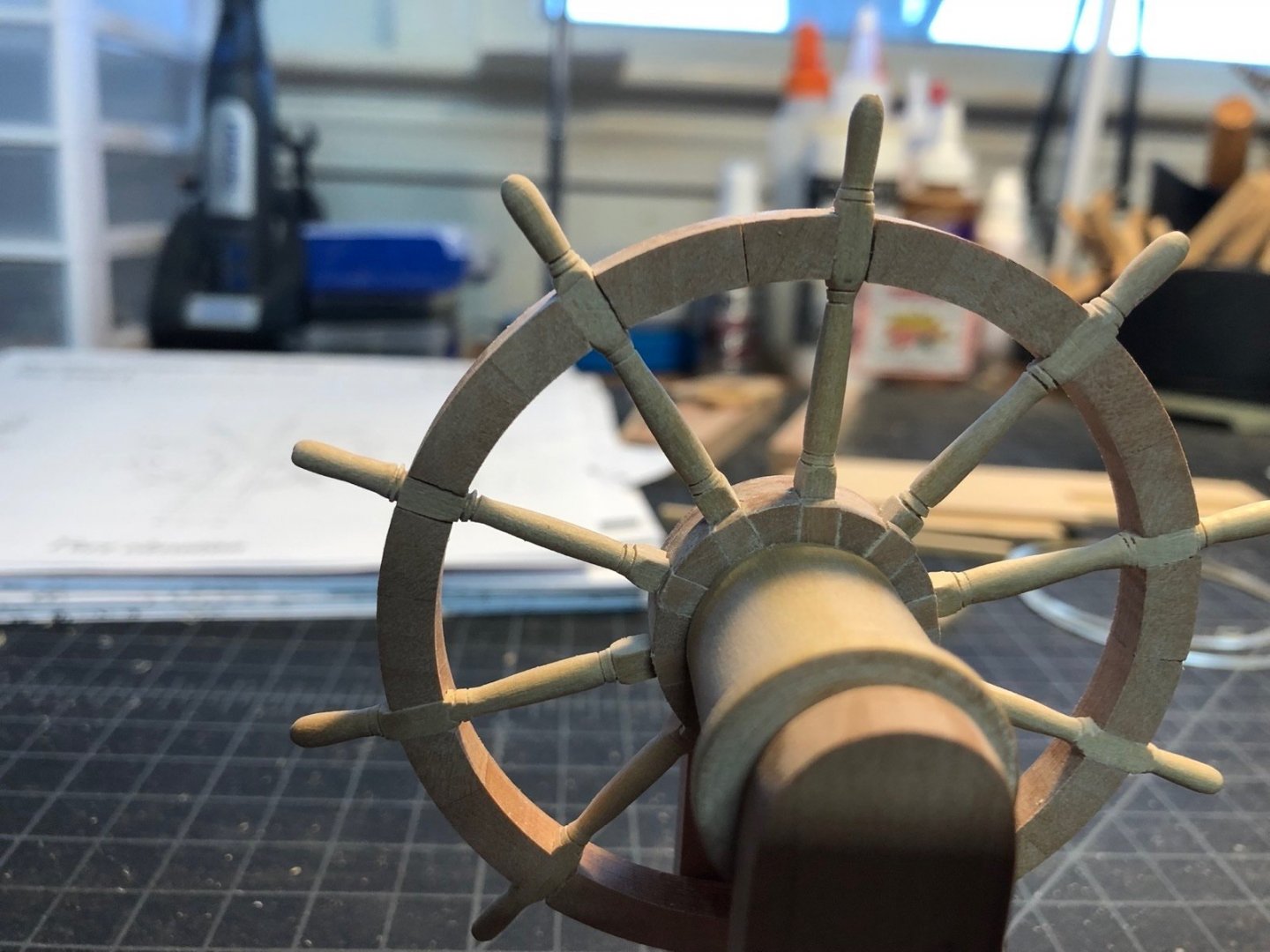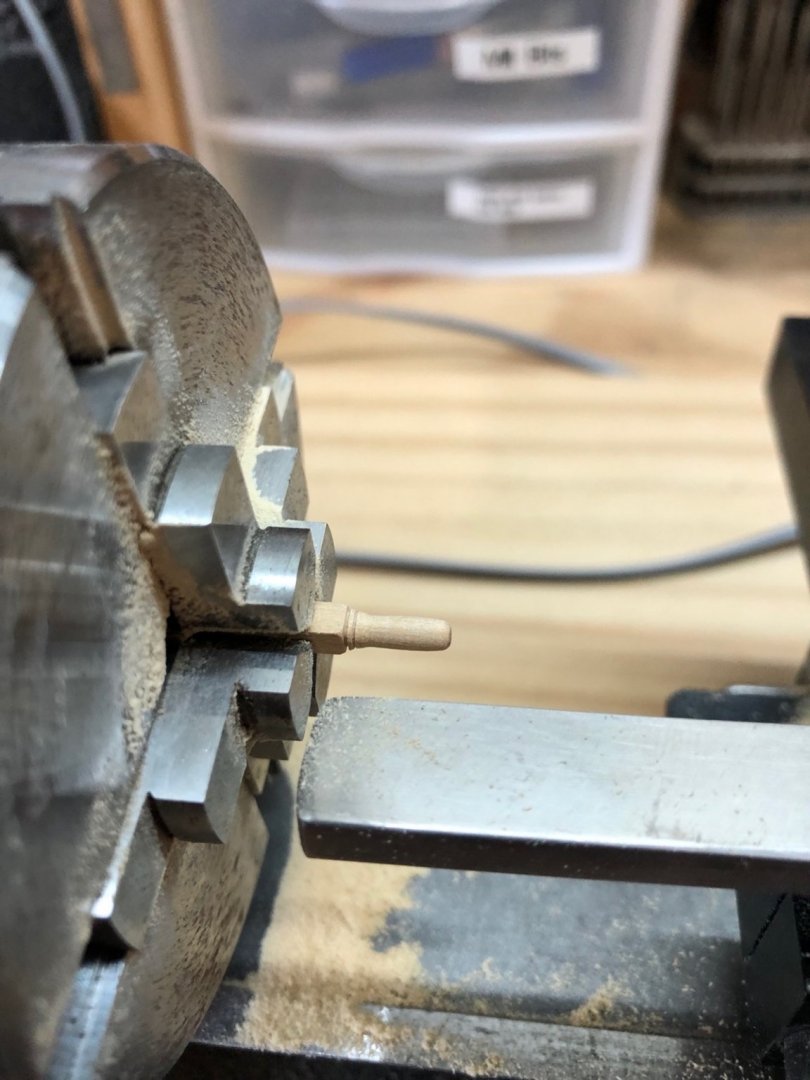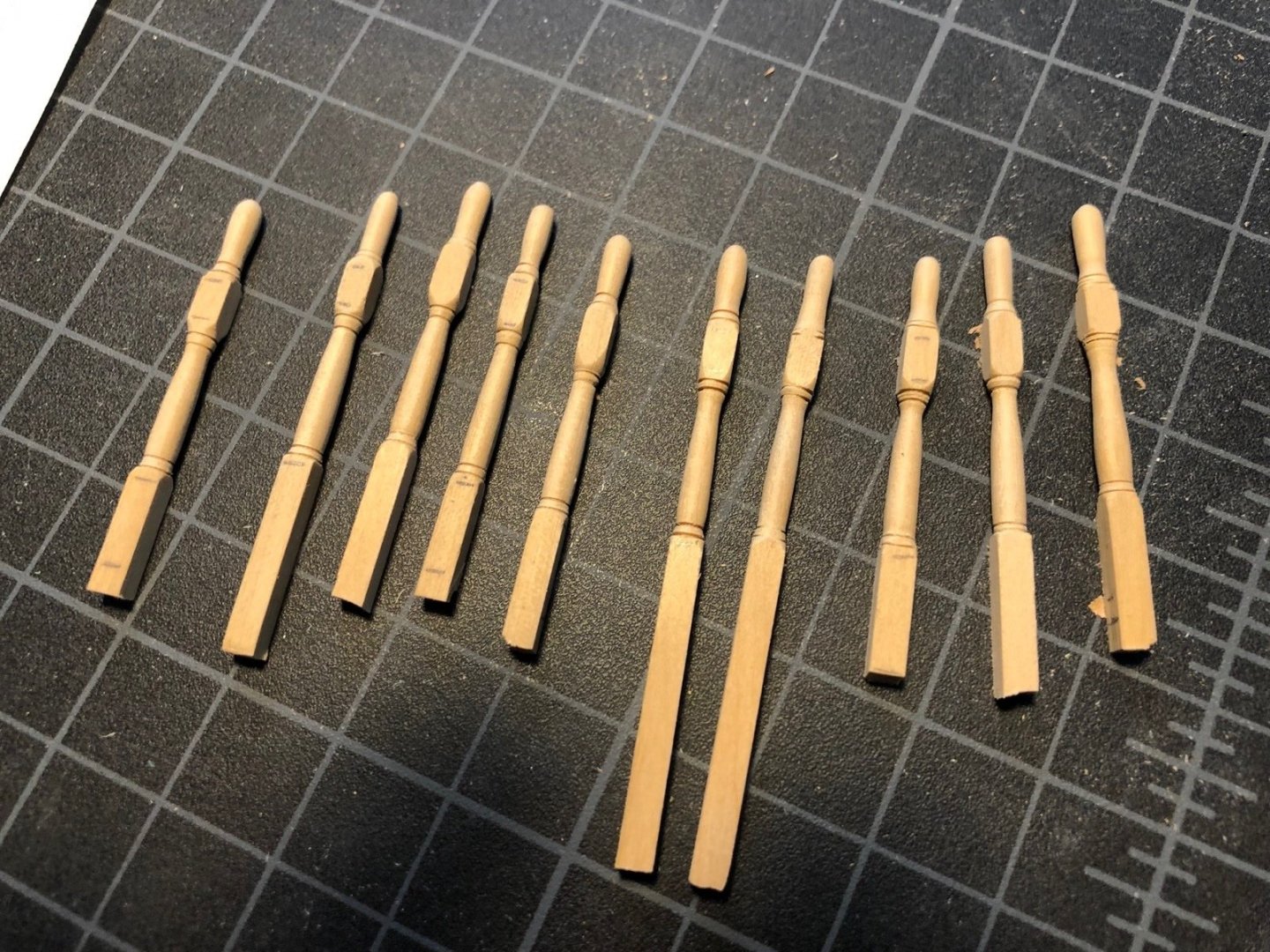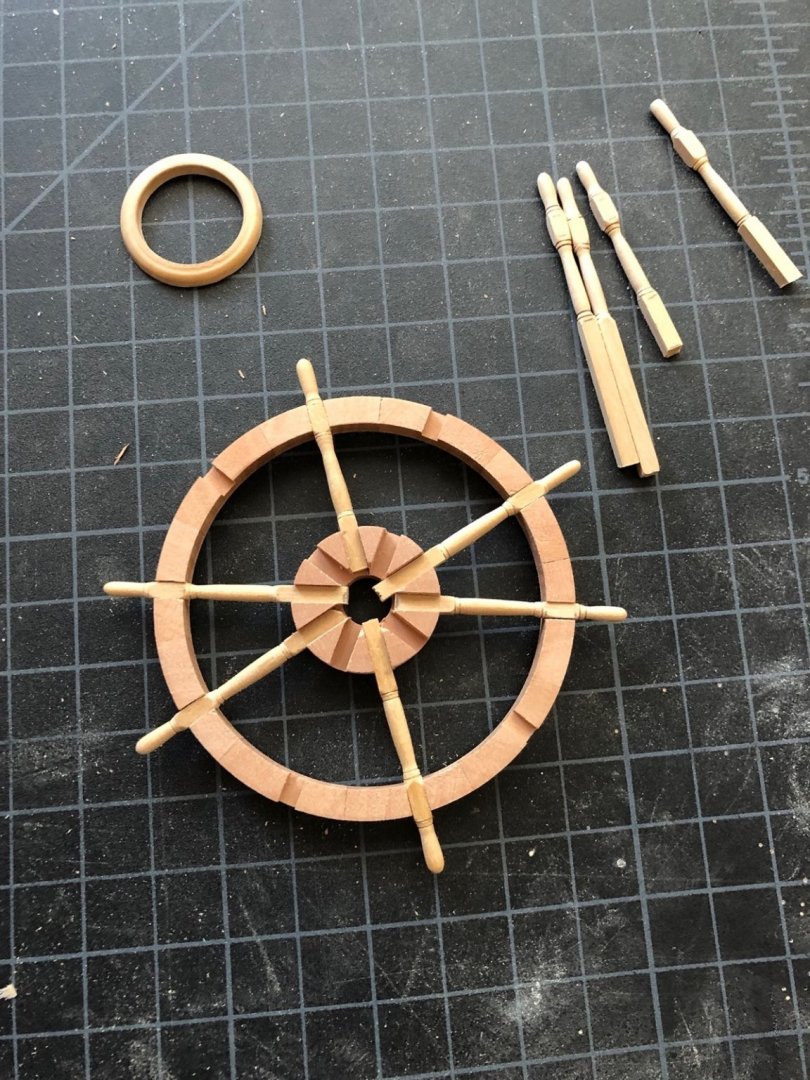-
Posts
2,407 -
Joined
-
Last visited
Content Type
Profiles
Forums
Gallery
Events
Everything posted by usedtosail
-
Thanks Glenn. I have measured out the planks with tick strips - I just didn't mark them on the hull. I added another row and again the edge bend changed direction. Very strange to me but it is working. I trimmed the planks at the transom and sanded them back to the transom. Here is how this area looks so far.
- 118 replies
-
- Duchess Of Kingston
- Finished
-
(and 1 more)
Tagged with:
-
Second planking continues. I was having no problems with the bow planks lying flat until the sixth and seventh planks, but I found that if I edge bent them in the opposite direction then I bent the previous planks they laid down flatter. I have not seen that before. I am also just to the point at the stern that I need to add a bend up to the transom. So far that is going well. Here is the state of the planking so far.
- 118 replies
-
- Duchess Of Kingston
- Finished
-
(and 1 more)
Tagged with:
-
Thanks Bob and for the likes. After all four stem and keel outer pieces were glued on I took some time to clean up all the rabbets along the stem and stern post. I used chisels to thin down the first planks along the stern post so the second layer planks have room to fit into the rabbet. With that done I started the second planking using the provided pear strips. I usually soak my planks before I bend them, but since other builders have been having success bending them without soaking I thought I would give it a try. It worked very nicely. I am doing the second planking in three sections per plank. For the bow section I first do an edge bend then the larger bend for the curvature of the bow. For the other two sections I just give them a bit of an edge bend. The nice thing with dry bending is that the plank is ready to glue on shortly after bending instead of the next day. And I am using medium CA to glue them on so no clamps are required, although I use them when I can, and again I don't have to wait long for the glue to dry. I have the first two planks done and I am really happy with the result so far. I am using the planks full width except for a taper at the bow. I should be able to hold to that all the way down but I will recheck as I go.
- 118 replies
-
- Duchess Of Kingston
- Finished
-
(and 1 more)
Tagged with:
-
And here is the finished project. This was fun and I am displaying it next to the capstan which is in the same scale. If I was still working I'd put them on my desk but I don't have one of those anymore more (which is a good thing). I am not sure what my next scratch build project will be but for now I will be putting all my attention on the Duchess of Kingston build. Thanks for watching.
-
Here is the last step. I put the beams in a vise and threaded the tiller line ends through the guide and into the eyebolts I had placed under the plank. I seized the ends, pulled everything tight, and covered the seizings with Dullcote lacquer. When they are dry I'll trim the excess and the project will be done.
-
Both upper hull pieces are now glued on. I glued them in thirds to make sure they stuck well all along the length. I then cleaned up the outer bow and keel pieces and have glued on the port bow piece.
- 118 replies
-
- Duchess Of Kingston
- Finished
-
(and 1 more)
Tagged with:
-
B.E. I think the extra work you put into those quarter galleries really paid off. They look great.
- 857 replies
-
- Sphinx
- Vanguard Models
-
(and 1 more)
Tagged with:
-
Yesterday I glued the bow portion of the port upper hull piece to the hull after sanding the front edge so the openings lined up. I have to say having those holes in the pieces so you can align them with the brass pins is just brilliant. Thanks @chris watton! It just makes aligning those pieces so much easier. Today I glued the rest of that piece to the hull. I needed lots of clamps, including longer reach clamps to make sure the bottom edge was held tight to the hull until the glue set. I had a couple and I modified some others with pieces of basswood which worked great. When this dries I'll do the same thing to the starboard side piece.
- 118 replies
-
- Duchess Of Kingston
- Finished
-
(and 1 more)
Tagged with:
-
I was able to bend the lower counter piece but not without a few breaks when trying to figure out how I was going to bend it. I was able to bend the individual pieces and glue them back together before installing it, which made it easier to align the pieces. I had to do a little more trimming of the plank ends along the sides of the transom to get it to fit right. I used the upper counter piece to make sure I had it at the right height on the transom. I then sanded the edges so they were flush with the planks, bevelled the upper counter piece and glued it in place, then sanded its edges. Here is how that all came out. I also filled the gap at the ends of the starboard planks with some wood filler. Today I soaked the bow areas of the upper hull pieces and clamped them to the hull to dry. I heated up water in the microwave for 3 minutes then poured it into a coffee can and put the pieces in bow first for 30 minutes. They bent very easily after that. I will let these dry for a good 24 hours before I remove the clamps.
- 118 replies
-
- Duchess Of Kingston
- Finished
-
(and 1 more)
Tagged with:
-
I have cut all the planks to length and around the mast hole. Here they are dry fit to the beams. I drilled holes for the treenails and glued them in. I also added two blackened eyebolts under the plank with the tiller rope guides to use to tie off the ends of the tiller rope. I also pushed the nail from the barrel through the middle of the tiller rope and glued it back into the barrel. Next I will wrap the rope around the barrel and fix it with some diluted white glue to the barrel.
-
I wasn't happy with the way the wheel was sitting on the barrel so I carefully removed it with some isopropyl, did some filing on the inside of the barrel and re-glued the wheel on. It looks much better. I also removed the stanchions and re-glued them back onto the beams so the mizzen mast hole was centered under the planks. I milled slots in the plank piece that will go under the barrel with the tiller rope guide piece on top, then glued them together and added treenails to the corners. I couldn't find my draw plate (it may have been lost in the move three years ago) so I made the treenails by chucking some small dowels in the Dremel and turning them down with a pin vise. This worked really well. Here they are installed on the plank. These are just decorative so I can add them before installing the planks. I think I an finally ready to put all the pieces together.
-
Hi Keith. I think it came out quite nice. You can see the finished ship in the photos above or in the gallery. It took me just about a full year to build. If you do decide to build it please start a build log and let me know. I would love to follow along.
- 131 replies
-
- santa lucia
- panart
-
(and 1 more)
Tagged with:
-
Yes I would also be interested in a POF kit. Probably the only way I would tackle such a project.
- 1,784 replies
-
- winchelsea
- Syren Ship Model Company
-
(and 1 more)
Tagged with:
-
I am happy to report that the patient has had a full recovery. I had pre-bent all of the planks I needed yesterday so today I was able to trim them and glue them in place. I used medium CA for this so that let me do all the planks in a few hours. Here is how the stern ends of the planks now look. If you look carefully you can see that there is a horizontal frame just under the plank ends that the planks need to cover vertically. Keep that in mind if you build this model in the future. And here is the counter piece just taped across the stern. I have not bent it to fit the frames yet. You can see that I could have extended one more plank on each side, but I'll just use some wood filler in those holes since this is just the first planking. I think the bottom of the counter piece stands proud of the plank ends and acts as a rabbet for the second planking.
- 118 replies
-
- Duchess Of Kingston
- Finished
-
(and 1 more)
Tagged with:
-
A little elective surgery today on the planks at the stern. As I was test fitting the stern post I had to trim the plank ends back more so it would fit between them. In the process I could see that I did not curl the planks up far enough to the counter and there would be a big gap between the plank ends and the counter piece. To fix this I removed the ends of the too short planks and bent new planks to replace the ends. I put a more severe bend into these planks using the center of my electric plank bender, which is a smaller diameter than the end of the bender. This burnt the inside of the planks at the bend but this won't be seen. I had a feeling I was going to have to do this as I was planking because I really couldn't figure out how far up to bend the planks and where they should end. I may have a small gap between the counter and the remaining planks but I can fill that with wood filler. I will be replacing these plank ends over the next few days.
- 118 replies
-
- Duchess Of Kingston
- Finished
-
(and 1 more)
Tagged with:
-
Thanks Roger. I really appreciate the comments. And thanks for the likes too. I am starting to put the pieces together. I glued the wheel to the barrel and the stanchions to the beams. I added a small square piece of boxwood to each of the stanchions so I had a supports to hold the plank I will fit between the stanchions. I also made a new piece that I decided to add under the barrel. From the beginning of this project I have wanted to add the tiller rope to the barrel. The only problem is that on the Swan class ships the tiller rope did not go through the quarterdeck, but instead lead to blocks along the inner bulwarks. Well since I have no bulwarks I had nowhere for the rope to go. I knew I didn't want to leave the ends just hanging from the barrel. Recently, on Chuck's Winchelsea build log, he shows a piece of wood under the wheel with two slots for the tiller rope. I liked the look of this piece so much I decided to take some artistic license and make one for this display. This will allow me to have the tiller rope go through the the deck, where I can tie the ends off. This may not be all that realistic but it does solver a problem for me. Is this too much of a stretch? Thoughts? Here is a dry fit of the parts so far. The planks need to be cut to length and I will glue black construction paper to one edge for the caulking. I made treenails from toothpicks that I will add after the planks are installed. I also have the tiller rope made and added a nail to the barrel to hold the rope when I install it. It is just set in the hole for now.
-
I have done a rough sanding of the first planks, then added wood filler a couple of times with more rough sanding in between. I then did some finer sanding of the whole hull. It is getting there but I used more wood filler than I would have liked. It is the first planking so I am not too concerned but I have got to do a better job on the second planking.
- 118 replies
-
- Duchess Of Kingston
- Finished
-
(and 1 more)
Tagged with:
-
I am almost finished with adding the first layer of planks. For the last two on each side I decided to add a drop plank at the stern as it was pretty narrow there. I first cut a plank to fill the gap then added a notch for the last plank. I had also glued a support behind the upper and lower planks so I had a place to land the end of the last plank. I then cut the last two planks and bent them to the frames to dry. I'll finish trimming the ends when I glue them into the gap. Then it's the so fun sanding, filling, sanding loop until I have a nice smooth surface for the second planking.
- 118 replies
-
- Duchess Of Kingston
- Finished
-
(and 1 more)
Tagged with:
-
I gave all the pieces made so far a coat of wipe on poly. I then glued the two brass rings to the rim using thin CA. I chucked the assembly board into the three jaw chuck and mounted the chuck on the rotary table in the mill. I clamped the wheel to the board and drilled the holes through the brass rings into the spokes and rim. I used a starter bit first and used the sensitive drill attachment for all the drilling operations. I then cut the heads off brass nails and glued them into the holes with medium CA. Here is one side with the nails. I will add the nails to the other side after these dry. I am going to leave the brass rings and nail heads bright as this is more of a display piece than a truly realistic representation. Its almost time to start putting the pieces together.
-
I finished adding the spokes to the rim and hub. I also milled two brass rings that will go on each side of the rim and will cover the slots with the spokes. The slots are much deeper on the hub so I cut small pieces of pear to fit over the spokes and fill the rest of the slot. I sanded these down so they are flush with the hub, then cleaned out the hole in the hub so the wheel fit nicely on the barrel. Here it is dry fit to the barrel and stanchions without any finish on these pieces yet. You can also see the brass rings in the background with the material for the planks. Here is a close up of those filler pieces in the hub. And a shot of the other side of the wheel. I still have some cleaning up to do on these pieces then I will apply a coat or two of wipe on poly. I'll add the rings and pins to hold them later. I have cut the planks to width and can start putting the beams together after I apply some finish to those pieces as well.
-
I finished making the 10 spokes for the wheel then made one to experiment on. The plans in David's book show more detail on the spokes so I used the extra spoke to try adding detail with various small chisels. I found that using the tip of an X_Acto blade, resting on the steady rest, made a nice small groove so I added two grooves at each transition from round to square. While the spokes were in the lathe I also sanded the round sections with 400 grit sandpaper. I ended up remaking two of the spokes because I didn't like how they compared to the others. Here are the 10 spokes ready for fitting to the rim and hub. I started fitting the spokes to the rim and hub by first making sure the notches were wide and deep enough to fit the square sections of the spokes. I then filed a flat onto the back of the outer square section to fit around the rim. I then marked where the spoke met the hub and filed a flat from there to the end of the spoke. Here are the first 6 spokes dry fit. I will have to wait until tomorrow to finish the other four. You can also see the mast coat I made in the last picture. Just a simple ring really.
About us
Modelshipworld - Advancing Ship Modeling through Research
SSL Secured
Your security is important for us so this Website is SSL-Secured
NRG Mailing Address
Nautical Research Guild
237 South Lincoln Street
Westmont IL, 60559-1917
Model Ship World ® and the MSW logo are Registered Trademarks, and belong to the Nautical Research Guild (United States Patent and Trademark Office: No. 6,929,264 & No. 6,929,274, registered Dec. 20, 2022)
Helpful Links
About the NRG
If you enjoy building ship models that are historically accurate as well as beautiful, then The Nautical Research Guild (NRG) is just right for you.
The Guild is a non-profit educational organization whose mission is to “Advance Ship Modeling Through Research”. We provide support to our members in their efforts to raise the quality of their model ships.
The Nautical Research Guild has published our world-renowned quarterly magazine, The Nautical Research Journal, since 1955. The pages of the Journal are full of articles by accomplished ship modelers who show you how they create those exquisite details on their models, and by maritime historians who show you the correct details to build. The Journal is available in both print and digital editions. Go to the NRG web site (www.thenrg.org) to download a complimentary digital copy of the Journal. The NRG also publishes plan sets, books and compilations of back issues of the Journal and the former Ships in Scale and Model Ship Builder magazines.





